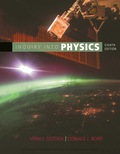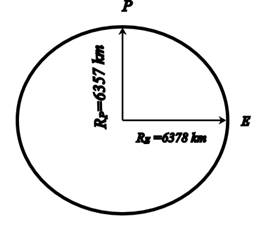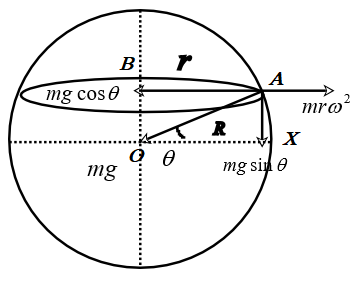
Concept explainers
Why the acceleration of a freely falling body is less in the Galapagos island at the equator and more a Oslo, Norway?
Answer to Problem 7C
The acceleration of free fall is different at different latitudes because of the following reasons:
(i) The radius of the earth is greatest at the equator and the acceleration of free fall at points close to the surface of the earth is inversely proportional to the square of the radius of earth at the point.
(ii) Due to rotation of the earth, the points on the surface of the earth experience an outward force depending on the latitude.
Explanation of Solution
Introduction:
Acceleration of free fall is the acceleration experienced by a body due to the force of gravitation acting on it. This is given by the expression,
Here, G is the universal gravitational constant, M is the mass of the Earth and R is the radius of the earth.
(i) Earth is not a perfect sphere. It is bulged at the equator and flattened at the poles. The equatorial radius is estimated to be 6378 km and the polar radius is around 6357 km. The difference between the equatorial and polar radius is about 21 km.

Since
(ii) The earth rotates from west to east with an

Consider a point A located at a latitude
Resolve the gravitational force mg into two components,
The net force along AB is given by,
From the triangle OBA,
Therefore,
The force along AX is given by,
The net force acting on the mass is given by,
From Newtons second law,
Here,
From equations (1),(2), (3) and (4),
Simplify the expression.
The value of
Hence,
Using binomial expansion and neglecting all higher powers of
At equator the latitude is zero,
At the poles, the latitude is 90°, the acceleration of free fall at poles is given by,
It can be seen that the value of
Conclusion:
Thus, the acceleration of free fall is different at different latitudes because of the following reasons:
(i) The radius of the earth is greatest at the equator and the acceleration of free fall at points close to the surface of the earth is inversely proportional to the square of the radius of earth at the point.
(ii) Due to rotation of the earth, the points on the surface of the earth experience an outward force depending on the latitude.
Want to see more full solutions like this?
Chapter 2 Solutions
Inquiry into Physics
- You wake up in a strange room, and this time you drop a ball from a height of 1.74 m, and observe that it hits the floor 0.298 s after you drop it. In this case you suspect you are in deep space, far from any planet or star, and that your rocket is accelerating due to the push of its own engines under the floor. In this case, what must the acceleration of your rocket be? 74.5 m/s^2 74.5 m/s^2 19.6 m/s^2 29.4 m/s^2arrow_forwardyou wake up in a strange room, and this time you drop a ball from a height of 1.79 m above the floor. The ball hits the floor 0.242 s after your drop it. You guess that you must have been taken to an alien planet with gravity different from Earth s. What is this planet s g (that is, the magnitude of the acceleration due to gravity on this planet)? 61.1 m/s^2 30.6 m/s^2 45.9 m/s^2 91.7 m/s^2arrow_forwardyou drop a ball from a height of 2.00 m above the floor. The ball hits the floor 0.319 s after your drop it. You guess that you must have been taken to an alien planet with gravity different from Earth s. What is this planet s g (that is, the magnitude of the acceleration due to gravity on this planet)? 29.5 m/s^2 59.0 m/s^2 39.3 m/s^2 19.7 m/s^2arrow_forward
- A rubber stopper on the end of a string is swung steadily in a horizontal circle. In one trial, it moves at speed v in a circle of radius r. In a second trial, it moves at a higher speed 3v in a circle of radius 3r. In this second trial, is its acceleration (a) the same as in the first trial, (b) three times larger, (c) one-third as large, (d) nine times larger, or (e) one-ninth as large?arrow_forwardAn astronaut hits a golf ball on the Moon. Which of the following quantities, if any, remain constant as a ball travels through the vacuum there? (a) speed (b) acceleration (c) horizontal component of velocity (d) vertical component of velocity (e) velocityarrow_forwardSuppose that on earth you can throw a ball vertically upward a distance of 2.10 m. Given that the acceleration of gravity on the Moon is 1.67 m/s2, how high could you throw a ball on the Moon? (Take the y-axis in the vertical direction, and assume that the location of your hand is at y = 0.)arrow_forward
- It takes earth 365 days to complete one orbit around the sun. Knowing that the magnitude of the average acceleration of the earth experiences is over half an orbit is 3.78×10-3 m/s2 , what is the average speed with which it travels?arrow_forwardYou wake up in a strange room and you drop a ball from a height of 1.02 m above the floor. The ball hits the floor 0.319 s after your drop it. You guess that you must have been taken to an alien planet with gravity different from Earths. What is this planets g (that is, the magnitude of the acceleration due to gravity on this planet)? 36.0 m/s^2 20.0 m/s^2 10.0 m/s^2 15.0 m/s^2arrow_forwardAn object is dropped in an unknown planet from height 50 m, it reaches the ground in 2 s . The acceleration due to gravity in this unknown planet is __________. a. g = 20 m/ s^2 b. g = 15 m/ s^2 c. g = 25 m/ s^2 d. g = 30 m/ s^2arrow_forward
- The NEXT morning, you wake up in a strange room yet again, and this time you drop a ball from a height of 2.15 m above the floor. The ball hits the floor 0.265 s after your drop it. You guess that you must have been taken to an alien planet with gravity different from Earth s. What is this planet s g (that is, the magnitude of the acceleration due to gravity on this planet)? 61.2 m/s^2 30.6 m/s^2 45.9 m/s^2 97.9 m/s^2arrow_forwardthis time you drop a ball from a height of 2.20 m, and observe that it hits the floor 0.335 s after you drop it. In this case you suspect you are in deep space, far from any planet or star, and that your rocket is accelerating due to the push of its own engines under the floor. In this case, what must the acceleration of your rocket be? 39.2 m/s^2 39.2 m/s^2 29.4 m/s^2 62.7 m/s^2arrow_forwardWhile playing sock baseball in the living room, a child swings a pair of socks attached to the end of a string in a circular path above his head. If the socks travel at a constant speed of 3.7 m/s and the string is 0.4 m long, what is the acceleration (in m/s2) experienced by the socks?arrow_forward
 Principles of Physics: A Calculus-Based TextPhysicsISBN:9781133104261Author:Raymond A. Serway, John W. JewettPublisher:Cengage Learning
Principles of Physics: A Calculus-Based TextPhysicsISBN:9781133104261Author:Raymond A. Serway, John W. JewettPublisher:Cengage Learning
